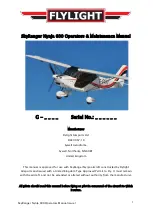
7
Correctly connect the risers to the attachment points so that the risers
and lines are correctly ordered and free of twists. Check that the IKS and
carabiners are properly fastened and securely locked.
2.4 TYPE OF HARNESS
The HOOK 5 can be flown with all current harness types. We recommend
setting the chest strap to the distance specified in the certification report -
this will vary depending on size.
Care should be taken with the chest strap setting, as the distance of the
chest strap setting will affect the handling of the glider. If the chest strap is
too wide, it allows greater feedback but this carries the risk of affecting the
stability of the wing.
If the chest strap is set too tightly, the wing feels more solid, but there is a
loss of feedback and a risk of twisting in the case of a violent asymmetric
collapse.
2.5 SPEED-BAR
The speed-bar is a means of temporary acceleration by changing the
flow over the profile. The speed system comes pre-installed on the risers
and is not modifiable as it conforms to the measurements and limits
stipulated in its certification.
The HOOK 5 includes a speed system with maximum travel depending
on its size (see Full speed-bar).
The speed system is engaged when the pilot pushes the speed-bar - not
included as standard with this glider model - with their feet (see 2.5.1
Speed system assembly)
The speed system uses an action/reaction system. Released, the speed-
bar is set to neutral. When the bar is pushed using the feet, the wing
accelerates. The speed can be regulated by varying the pressure on the
bar. Once the pressure on the bar is released, the speed system returns
to the neutral setting.
The speed system is efficient, sensitive and precise. The pilot can use the
system whenever they want during the flight. In the neutral position the
glider will fly at the standard speed and glide. Using full speed-bar, the
wing will fly at maximum speed, but the glide will be adversely affected.
•Released speed-bar: the A, B, C-risers are aligned.
•Full speed-bar: the difference between the A - C-risers becomes:
Size 20, 22 and 24 - 133 mm
Size 26, 28 and 31 - 140 mm
Please note!
The use of the speed system results in changes to the speed and
reactions of the wing. For more information, please see the certification
report.
2.5.1 SPEED SYSTEM ASSEMBLY.
The speed-bar consists of the bar that the pilot pushes with their feet, as
well as the two cords that connect it to the speed system components
on the risers. Once you have chosen the type of speed-bar you prefer,
you must install it. Some considerations:
• You should use the type of speed-bar you consider appropriate,
depending on the type of harness, personal preferences, etc.
• The speed-bar is detachable to facilitate its connection and / or
disconnection to the risers as well as subsequent adjustment.
• To connect it to the harness, please follow the instructions of the
harness manufacturer. The majority of harnesses have a speed system
pre-installed.
• The standard connection of the speed-bar to the speed system is via
Brummel hooks, where two slots in the hooks are interlocked, making
their connection / disconnection easy. However, any connection system
that is safe may be used.

































